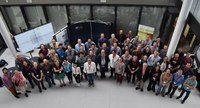EUCALL achievements and future prospects
From 30 May to 1 June 2018, over 60 EUCALL participants met in Dolní Břežany, Czech Republic, for the project's final annual meeting at ELI-Beamlines. Over the past three years, the EU-funded project EUCALL has brought together experts from high-power optical laser, synchrotron and free-electron laser facilities to work on common technologies and collaborate on solutions to challenges facing their fields.
Laserlab-Europe is one of two networks and thirteen facilities taking part in the European Cluster of Advanced Laser Light Sources (EUCALL, Horizon 2020 Grant Agreement No. 654220). Since the project funding period ends on 30 September 2018, those at the meeting spent the majority of their time strategizing the last tasks and making plans for extending the collaborations initiated through EUCALL.
Such a meeting was also a ripe time for reflection on the project's successes. EUCALL Coordinator and European XFEL Scientific Director Thomas Tschentscher opened the meeting praising the efforts of those involved and going over the project's results so far. Dozens of papers linked to EUCALL developments have been published, with at least ten ending up in high-impact journals. Many of the attendees also expressed satisfaction over what had been developed through the project. One example is the SIMEX simulation software, which was developed from one of EUCALL's four technical work packages, and models experiments at light sources from source to detector. SIMEX has been commented on by the EUCALL's project reviewer as being an "invaluable" tool.
Among the most recent successes at the time of the meeting were the development of HIREP's standardised high repetition rate target delivery system for high power laser facilities, and the successful use of the diverse PUCCA diagnostics and timing tools at the European XFEL's FXE instrument. UFDAC, a work package offering firmware for ultrafast data acquisition and analysis needed to deal with high data throughput, is attracting attention with its benchmark 10 GB/s rate of processing data. Present at the meeting were various researchers and instrument scientists who have begun to integrate these EUCALL technologies into their infrastructures. For example, researchers working on the MicroMAX beamline at the MAX IV synchrotron in Sweden said they were excited to start working with HIREP technologies, and a visitor from the LCLS X-ray free-electron laser in California discussed building on the SIMEX platform for their LUME simulation program.
In addition to plenary sessions and breakout working time for the technical groups, the meeting also featured talks on other international light source collaborations such as LEAPS and Laserlab-Europe and a presentation on www.wayforlight.eu – a database of light source facilities, which will be significantly expanded as a consequence of EUCALL efforts, to include not only synchrotron and free electron laser facilities, but also laser and laser-driven light sources.
One common theme at all talks was how the different teams could continue collaborating beyond the EUCALL end date. Attendees proposed several ideas, with a scope either within their individual work packages or extending to all project partners and beyond. Some already made plans, such as a continuation of SIMEX into a future open science cloud networking project, and a Target Development Network that will help facilities collaborate on sample delivery systems such as those developed in HIREP.
Joseph Piergrossi (European XFEL)


